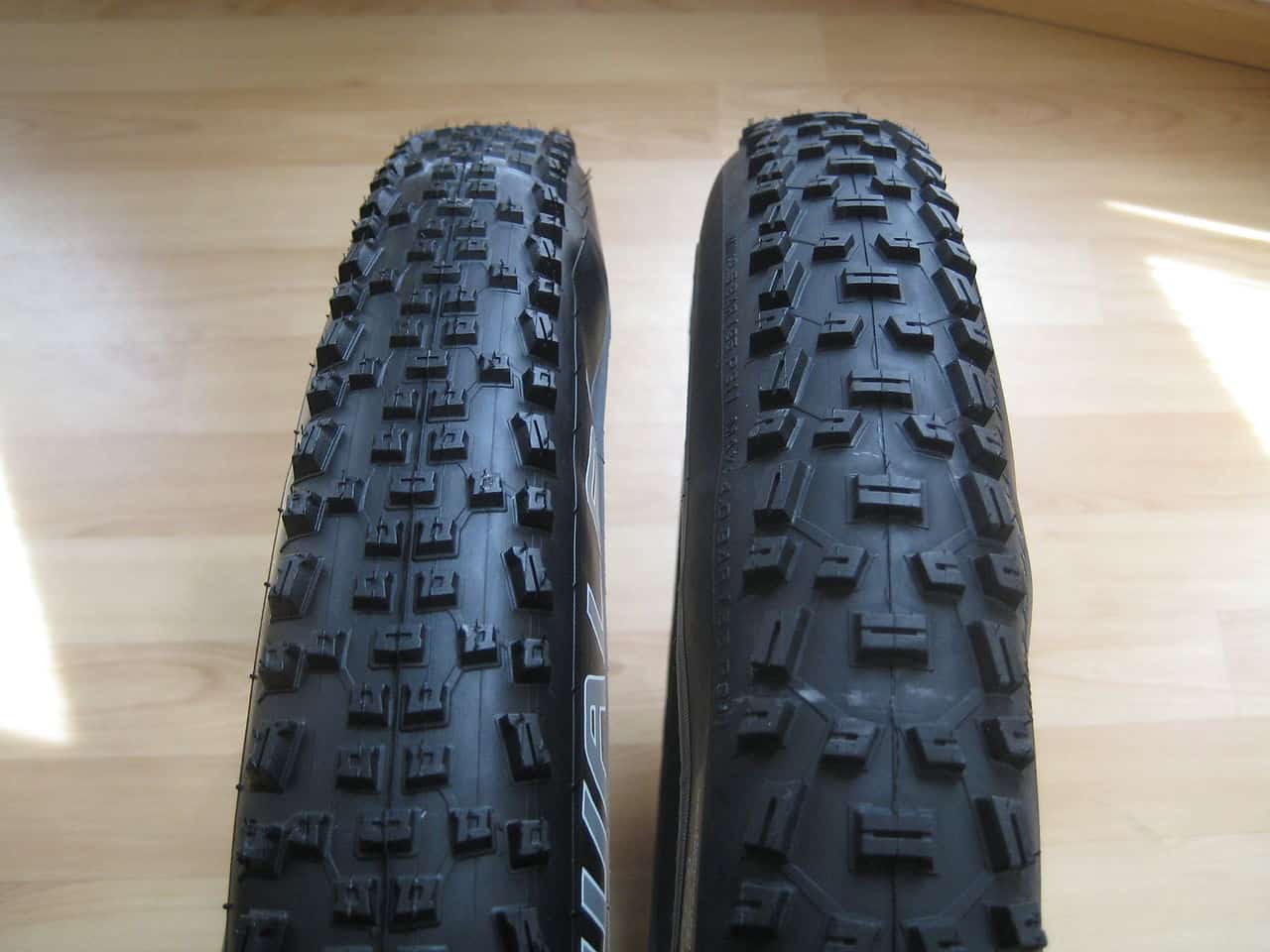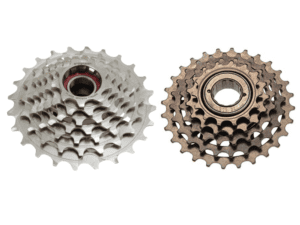In this article, I will try to explain the sizes in the simplest form possible, go through the standard sizes across the globe, look into wide tires, ISO sizes, and other road bike and mountain bike wheel sizes.
By the time you’re done reading this, you’ll know how to fit the right tires for your rims and save yourself the hassle of returning the wrong tires after an hour of trying to force them on.
Why Are There So Many Different Tire Systems?
The root of the confusion that you feel when you see all the different tire sizes on the market ultimately lies in the history of bike making. Each brand develops a country-specific measuring system like the decimal, fractional, and French.
Since biking construction is a global enterprise, the conflict between measuring systems became much more of an issue. Although the cycling industry has made efforts toward simplifying its wheel sizing, there are still many confusing aspects of determining the right tire size for your wheel.
If only there were a system that worked perfectly for all tire sizes.
ISO Tire/Rim Size: Sweet Standardization at Last
Enter the ISO system! Developed by the European Tyre and Rim Technical Organization, this system allows you to accurately determine the fit of your tire or wheel based on two simple measurements.
Two numbers describe the ISO tire size:
- The width of the inside of the tire in millimeters
- The tire’s diameter at the tire bead (the inside edge of the tire) – also in millimeters.
When measuring rims, the ISO system uses the inside diameter of the rim and the rim’s width inside the sidewalls.
For example, a 700c x 35 tire has an inside width of 622 mm, and a bead seat width of 35 mm. If your 700c tire lacks a second measurement, you can measure the inside of the rim to find the width and select a compatible tire.
Generally speaking, you want to pair a rim with a tire with an ISO bead seat measurement 1.5-2x bigger than the rim’s ISO sidewall measurement.
What Is The Difference Between The Nominal Size And ISO?
Frankly, nominal size doesn’t tell you what you need to know! While nominal sizing will give you a general measurement of the tire’s outside diameter (say, 29″) and the tire’s width, it fails to provide a clear signal of what tire will be compatible with your rims.
When it comes to sizing parts for your bike, a difference of a few millimeters can be the difference between the perfect fit and a complete non-starter.
If you want a one-and-done fit for your newest tires, I highly recommend using the ISO system to fit your tires to your rims.
Now that we have a solid grounding in accurately measuring tires and rims for fit, let’s return to the question at hand” is a 29″ tire the same as 700c?
29″ is the same as 700C
……But that’s not the whole story.
A 29-inch wheel would be the same as a 700C wheel, but you need to factor in the width of each wheel to determine compatibility. A 700C tire will fit on a 29-inch rim – provided there’s the same bead seat diameter.
A 29-inch wheel is the same as a 700C wheel most of the time. The “29-inch” designation uses the nominal sizing system, while the “700c” designation uses the French sizing system.
Both wheels have an ISO system measurement of 622mm and are effectively interchangeable. If your account is for the proper width, you can safely use the terms in the same way.
The only exception is using an old-style rim with less than 16 spokes per side, which may throw off your measurements slightly.
There is a bit of wiggle room with fitting tires to your rims: while it’s not perfect, you can get away with slightly too big or small tires for your rims.
However, you open yourself up to the possibility of decreased traction on the road, pinch flats, and worse handling in the event of a sudden flat tire.
There’s some room to play, but if it doesn’t fit right around your rims or you notice something is off on your first ride, it’s best to swap it out for the appropriate size.
That being the case, a 700C tire will fit on a 29-inch rim, and you can confidently interchange the two measurements knowing that they’ll fit the same.
700c vs 29″ vs 650b
Let’s break each of these wheel sizes down by their respective sizing systems:
700c and 650b are both French system sizes. Fun fact: The “c” and “b” at the end of the number don’t stand for anything! They’re relative to each other; c will be wider than b.
700c wheels have an inside diameter of 622mm. Thin road bike wheels would have a 25-35mm rim width, meaning their ISO size would be 28-around 622. 650b wheels have an inside diameter of 584mm and a rim width in a similar range, giving them an ISO size of something like 25-584.
On the other hand, 29″ wheels are nominal system measurements. If we give them both a 1.5-inch rim width, they would have inside diameters of 622mm and 559 mm, respectively, and a rim width of roughly 38 mm, giving them an ISO size of 38-622 and 38-559, respectively.
It’s essential to consider the wheel’s inside diameter and the rim’s width inside the sidewalls- one measurement like “29” won’t give you the complete picture. ISO sizing is the most accurate because it uses millimeters, forcing manufacturers to be more precise with their sizes.
Many slightly different tire widths will fall under the umbrella of “1.5 inches”, just as a matter of convenience for the manufacturer.
So, is 29 inches the same as 700C?
Yes! But make sure that the rim widths are the same. 29″ (ISO size 622) is the same inside diameter as 700C, but some 29″ tires will not fit 700C road rims because they’re too wide.
Make sure to check the other necessary measurement, the beat seat diameter. That is also, helpfully, displayed in the ISO measurement on the side of the tire (e.x. 38-622).
Will a 700C tire fit on a 29″ rim?
Yes. A 700c tire or one of similar diameter will fit on an “ISO” (International standards) 28-29/700C rim without any modifications. This is assuming you have an equally-sized 700c/29″ tire.
How Do I Buy The Right Size Tires For My Bike?
Find the ISO sizing for your rims, and ensure that they’re compatible with the tires you’re looking to buy. You’re looking for the same inside diameter for the tire and the rim (let’s say, 622 mm). Plus, a tire with a bead seat diameter that’s 1.5-2x the size of the rim width, as measured inside the rim’s sidewalls.
Note: Bead seat diameter is the distance between the lips of the tire, which sit on the rim’s inside.
Therefore, if you’re looking to match a 22-622 rim, you’ll need a 44-622 tire. There’s a little bit of wiggle room with either measurement for a tighter or looser tire fit, but you don’t want to stray too far from the proper size.
FAQs about 29″ wheels and 700C wheels
Is 29-inch the same as 700C?
For all intents and purposes, yes, they are the same. The difference in name solely stems from the sizing systems used to sell them. While neither measurement tells you the width of the tire or rim, you can be confident that the diameter of the tire or rim will be the same, whether it’s 700c or 29 inches.
Is 29″ The Same as 700C?
There are minor variations in sizing those bike companies will label as “700c” or “29 inches”, but you should be able to use 29-inch tires with 700c rims and vice versa. Just be sure to check that the widths are compatible!
What is the 700C tire?
A 700c tire is a tire that has an inside diameter of 622mm. The bead seat diameter is the other vital measurement when determining whether your tire will fit the rim. The ISO sizing on the side of the tire will look something like 27(bead seat diameter)-622(inside diameter): 27-622.





